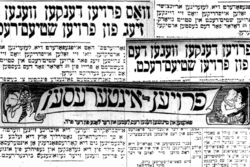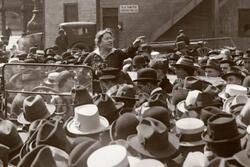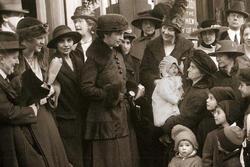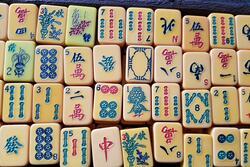Jewish Women and the Afterlife of the Suffrage Movement
This essay is part of JWA’s 2020 Suffrage Series on the blog.
One of the pro-suffrage arguments that anti-suffragists deemed either most ridiculous—or most dangerous—was the idea that once women got the vote, they would fundamentally transform the United States. There would be no more political corruption, incompetent governance, exploited workers, or other widespread evils, and peace and harmony would ring throughout the land. Anti-suffragists like Annie Nathan Meyer derisively referred to such thinking as “spreadhenism,” mocking the idea that once the hens were in charge the entire chicken coop would be hatched anew. Needless to say, that didn’t happen. Still, the ratification of the Nineteenth Amendment in 1920 brought with it high hopes and, post-suffrage, women began shaping government and public affairs.
The immediate post-suffrage formation of the Women’s Joint Congressional Committee to lobby for women’s interests led to some notable early victories for women as political players, including the Sheppard-Towner Act (1921), which provided federal funding for maternity and child care, and the Cable Act (1922), which secured independent citizenship for women regardless of their husbands’ citizenship statuses. The National Council of Jewish Women (NCJW) joined the Women’s Joint Congressional Committee very early on, in 1921, assuring Jewish women of a voice in American public life. As Constance Sporborg explained in her 1919 presidential address to the New York NCJW, “Now that our organization has 3,000 voters as well as 3,000 members, our influence can be more direct.”
Like other suffragists, Jewish women redirected some of their energies to their own communities. In the years just after the passage of the Nineteenth Amendment, they successfully demanded representation on synagogue boards across the country. In Atlanta, for example, women members of The Temple pointed out that “in this age of woman’s suffrage, the Sisterhood should demand the right to have a real working voice.” When Marion Misch became the first trustee of Temple Beth-El in Providence in 1921, she noted that “Jewish women are...esteemed not only supreme in their households, but as direct agencies for influence upon the affairs of the time.” Because suffrage had become a popular cause across divides of denomination, class, and ethnic origin, it is not surprising to find that women’s enfranchisement led to at least some changes within the American Jewish community writ large.
For a significant number of Jewish women, the ultimate success of the suffrage movement validated their interests in other social movements. It no longer seemed necessary to fight over the right to be involved in issues outside the home—especially when such issues could be linked to their traditional responsibilities within the home—so Jewish women became less defensive about their already strong commitments to world peace, birth control, labor, and Zionism, among many other causes. NCJW and Hadassah, for instance, had not waited for suffrage to become major players in social welfare and Zionism, respectively, but now there was no need to waste time justifying their considerable range of activities. Nor did they wait around for the large American Jewish organizations to set their agendas. When the men who ran the Joint Distribution Committee, established to help Jewish communities in Europe and Palestine devastated by World War I, refused to give women much of a role, NCJW sent its own women’s relief mission to Europe. Hadassah resisted multiple takeover efforts by the male leaders of the Zionist Organization of America, insisting that Zionist women retain their independence and autonomy. Meanwhile, throughout the 1920s and beyond, Jewish women flocked to the birth control and peace movements as expressions of both their religious and gender identities, now additionally empowered by enfranchisement.
For some Jewish women, formal politics remained the arena of choice. Just as there had been a split between the more moderate and more militant arms of the suffrage movement, in the aftermath of the Nineteenth Amendment there was sharp disagreement about whether to pursue an Equal Rights Amendment (ERA). Jewish women like Rebecca Hourwich Reyher and Anita Pollitzer lobbied tirelessly to bring the ERA to Congress, believing that without constitutionally protected legal equality women would always be at a disadvantage. Among their fiercest opponents was a whole other group of Jewish women, including Henry Street Settlement founder Lillian Wald and labor leaders Pauline Newman and Rose Schneiderman. They had vigorously supported suffrage but believed strongly in both the importance of protective labor legislation in improving the conditions of working women and the impossibility of legislating away differences between men and women. All these women greatly respected each other’s abilities and achievements, but met often in heated public debates.
Partisan politics also drew in Jewish women. This was not an entirely new phenomenon. Belle Fligelman Winestine had served as a campaign advisor and speech writer for Jeanette Rankin, a Montana Republican who was the first woman elected to Congress, even before the Nineteenth Amendment passed. But enfranchisement opened new doors to women in party politics that Jewish women were quick to walk through. Drawing on decades of experience as a social worker and labor activist, Belle Moskowitz became one of New York governor and 1928 presidential candidate Al Smith’s closest advisors and the most prominent women in the Democratic Party of the 1920s. Sadie Loewith became one of the most active Republican women in Connecticut and worked for the party in every post-1920 election, eventually serving as a Fairfield County Commissioner, as well. As the only woman on the National Recovery Administration Labor Advisory Board, Rose Schneiderman exerted a great deal of influence on the Democratic Party’s New Deal programs of the 1930s, including the Social Security Act and the Fair Labor Standards Act. And in 1925 Florence Prag Kahn, a California Republican, became the first Jewish woman elected to Congress. Although she originally replaced her husband after his death, Kahn went on to be elected to the House of Representatives five times in her own right.
For all these accomplishments, there was also some disappointment that enfranchised women had not, in fact, changed everything. As early as 1924, the League of Women Voters sponsored a symposium asking “Is Woman Suffrage Failing?” One of the Jewish contributors, Molly Lifshitz of the White Goods Workers Union, stoutly answered in the negative, pointing out that no one ever asked men if their suffrage was a failure, even though they had been voting for far longer and there were many problems in the world.
Still, it was unclear what came next for women voters. The Sheppard-Towner Act was not renewed when it expired in 1927, by which time it was clear that there would be no such thing as a “woman’s bloc,” given all the factors that divided women as much as united them. The 1920s also saw the rise of a sort of modernist individualism that complicated collective action. The fact that huge swaths of Jewish women remained involved in all kinds of reform, activism, and social movements is a testament to their insistence that the vote was but one more tool—though a critically important one—in the never-ending task of making the world a better place.







Very interesting. I learned a lot of facts that I did not know about after reading this informative subject